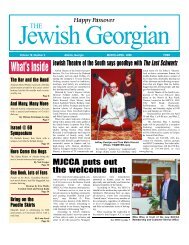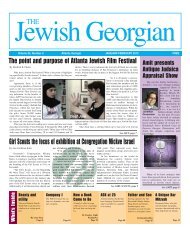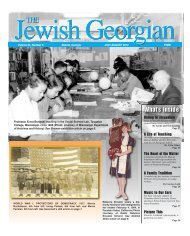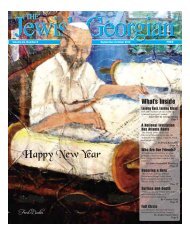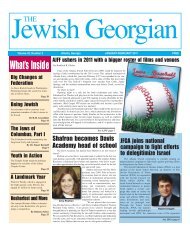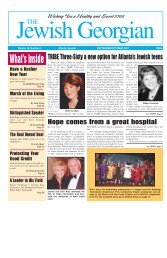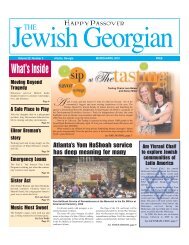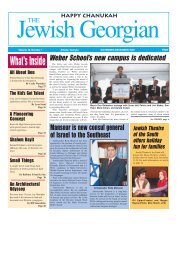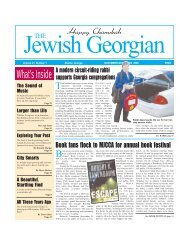You also want an ePaper? Increase the reach of your titles
YUMPU automatically turns print PDFs into web optimized ePapers that Google loves.
September-October 20<strong>08</strong> THE JEWISH GEORGIAN Page 35<br />
even as Rabbi Lew explained it, that it was<br />
the ashes and bones of all of our brothers<br />
and sisters.<br />
This 7-ton pit of ashes was the true<br />
memorial of Majdanek—it alone could testify<br />
to the horror of Nazism. It defied imagination—you<br />
can try to imagine 6,000,000<br />
people, but no human being can grasp that<br />
number, let alone that number of people<br />
dying. <strong>The</strong> closest you can come to realizing<br />
just how many Jews were slaughtered in<br />
the Holocaust is by looking deep into that<br />
ash pit and seeing the cremated remains of<br />
murdered Jews, replete with bits of bone.<br />
After it sunk in, I broke down. Flat out,<br />
lose-all-hope, broke down. Tears streamed<br />
down my face as I shuddered and cried. I<br />
cried like I did the day I was born—thrust<br />
into a new and scary world that I could not<br />
physically grasp or understand. I looked<br />
around and saw other people crying as well.<br />
Rabbi Lew, standing next to me, gave a<br />
caustic laugh and murmured, “This is what<br />
the Jews are worth! A pile of ashes!<br />
Unbelievable....”<br />
I tried to speak, but no words came out.<br />
<strong>The</strong>re are no words to describe that horror.<br />
As I let my emotions take control, I realized<br />
just how right the monument was—<br />
Majdanek cannot be described. You, as a<br />
reader, may be thinking, “Oh this is horrible,<br />
I had no idea how terrible a place this<br />
was…” or “I can understand how he was<br />
feeling.” Please, have no illusions.<br />
You truly cannot understand how I felt<br />
unless you were there, at Majdanek, three<br />
miles outside of Lublin, Poland. You can’t<br />
feel the strange numbness in the field at<br />
Treblinka, the absolute disgust in the twins’<br />
barracks at Birkenau, the body-shuddering<br />
horror of the gas chambers and crematoria<br />
at Auschwitz, or the utter desolation of seeing<br />
what’s inside the urn-shaped building at<br />
Majdanek. Even after seeing those sites,<br />
you still cannot grasp the Holocaust; the<br />
numbers are too great. But you can understand<br />
just what happened and can get much<br />
closer than books, movies, and photographs<br />
will ever take you.<br />
——-<br />
And then, suddenly, there I was, eating<br />
freshly baked pita and talking with some<br />
new friends on a chartered plane headed<br />
straight to our homeland of Israel. It was a<br />
flight attendant’s nightmare—the aisles<br />
were packed, people were lying across rows<br />
of seats, and everyone was having a good<br />
time.<br />
<strong>The</strong>n, I heard words that made my<br />
spine tingle.<br />
“Hey man, I think I see it!” my new<br />
friend Lucas shouted. I looked out the window,<br />
and, sure enough, I saw a tiny sliver of<br />
land. <strong>The</strong> excitement level doubled. <strong>The</strong><br />
flight attendant attempted to quiet us down<br />
to prepare for our descent into Tel-Aviv, but<br />
she couldn’t calm the beast.<br />
As we landed at Ben Gurion<br />
International Airport, the plane rang with<br />
the cheers and whoops of the entire<br />
Southern region, teens and adults alike. As<br />
soon as we left the terminal, I kissed the<br />
ground; I stood up with a mouthful of grav-<br />
el and a sense of pride and accomplishment—I<br />
was really in the land of Israel.<br />
After four long years, I had finally returned.<br />
Atlanta MOL participants (from left)<br />
David Schroeder, Shim Gartner,<br />
Jason Axelrod, and Zach Senft celebrate<br />
their arrival at Israel’s Ben<br />
Gurion Airport. (all photos courtesy<br />
MOL Atlanta Inc.)<br />
Our first stop was the Western Wall, the<br />
Kotel, widely considered the holiest site in<br />
all of Judaism. I could barely get to the<br />
Kotel due to the vast throng of Orthodox<br />
Jews, their heads bowed in meditation and<br />
deep prayer. I ended up just walking up to<br />
the wall, gazing at it for a few moments,<br />
pulling out a yarmulke from my back pocket,<br />
and praying the shema. It lasted about<br />
five minutes, but was easily one of the most<br />
powerful prayer experiences I have ever<br />
had.<br />
We drove to our youth hostel in Beit<br />
Shaan, in the northeastern part of the country,<br />
about two hours from the Old City in<br />
Jerusalem, and went to sleep early. Having<br />
traveled not only from Poland to Israel, but<br />
from persecution and terror to freedom and<br />
prosperity, we had experienced a very long<br />
day.<br />
<strong>The</strong> next morning, we began driving<br />
towards the Golan Heights. Well-known<br />
throughout Israel as a strategic location that<br />
we took from the Syrians during the Six-<br />
Day War, it is also a place of unmistakable<br />
grandeur. Atop the Golan Heights, one can<br />
see the Eastern mountains that separate<br />
Israel from Jordan. A short trail took us to<br />
an overlook, from which we saw the Sea of<br />
Galilee (the Kineret, in Hebrew) and the<br />
city of Tiberias, which sits right on the<br />
Western shore.<br />
Later that day, the Atlanta contingent<br />
visited our sister city, Yokneam-Megiddo.<br />
In the evening, we took part in a tekes<br />
(memorial ceremony). Most of Yokneam<br />
gathered at a basketball court to remember<br />
the young men and women who had lost<br />
Atlanta’s sister city, Yokneam, is the<br />
backdrop for the Atlanta MOL participants<br />
on Yom Ha’atzmaut.<br />
their lives protecting Israel this past year.<br />
Our job was to stand in formation with our<br />
hand by our sides, to act as a sort of guard,<br />
I suppose. While we were there, the Yom<br />
Hazikaron (Memorial Day) siren went off.<br />
Everyone stopped moving, and, from our<br />
vantage point on top of a hill, I could see<br />
cars stopping on the streets as well. <strong>The</strong><br />
siren went on for about a minute, during<br />
which time no one uttered a sound.<br />
In that powerful moment, I realized<br />
just how different Israel is from America.<br />
On our Memorial Day, we shop and have<br />
barbecues. On their Memorial Day, Israelis<br />
give tekesim to honor the brave soldiers<br />
who have given their lives so Israel can see<br />
independence for one more day. On<br />
Memorial Day, America celebrates and<br />
Israel mourns.<br />
<strong>The</strong> next day, we drove to Acre, the last<br />
stronghold of the Crusaders before it was<br />
taken over by the Mameluks in 1291 after a<br />
notoriously gory siege. What remains of the<br />
fortress at Acre is very elaborate, despite it<br />
being used in the 20th century as a prison<br />
and gallows site. After touring the fortress,<br />
we departed for Mitzpei Hoshaya, a small,<br />
rustic village. <strong>The</strong>re, inside a large Bedouin<br />
tent, we dined on pita, various dips such as<br />
hummus and babaganoosh, and roasted<br />
chicken with rice and vegetables.<br />
<strong>The</strong>n we went into a local synagogue to<br />
pray Ma’ariv and prepare for the coming of<br />
Yom Ha’atzmaut (Israel Independence<br />
Day). <strong>The</strong> service had some lively<br />
moments. Some friends and I joined a circle<br />
near the ark and started dancing with a<br />
group of Ethiopian Jews—one of whom<br />
claimed to be a distant nephew of Barack<br />
Obama!<br />
As the sun set and the moon rose, Israel<br />
suddenly went from a state of mourning to<br />
a state of wild celebration. This is the magic<br />
of Yom Hazikaron and Yom Ha’atzmaut.<br />
And since it was also the 60th anniversary<br />
of Israel, we knew that every Israeli would<br />
be celebrating twice as much. Once you go<br />
to Israel, you realize that it probably possesses<br />
the strongest patriotic identity of any<br />
country, since it is in constant turmoil and<br />
in risk of being taken away from its people.<br />
After we finished davening, we drove<br />
to Tiberias, boarded a party boat complete<br />
with a DJ who played popular techno hits as<br />
well as remixed, electronic <strong>Jewish</strong> music,<br />
and set out on the Kineret for two hours. It<br />
was a very fun time, just hanging out with<br />
friends, trying to dance to the weird music<br />
the DJ was playing, and celebrating Israel’s<br />
independence.<br />
After the boat ride (and a few hours<br />
sleep) we departed for Jerusalem, for the<br />
Gathering in Safra Square before the<br />
Jerusalem March of the Living<br />
second March of the Living. We arrived in<br />
Safra Square, which was teeming with the<br />
6,000 others who continued to Israel after<br />
touring Poland.<br />
We ‘’prepped’’ for the March by dancing<br />
and singing. Water bottles and water<br />
were flying all over the place; a few feet<br />
away from me, some Canadian guys were<br />
launching girls into the air—it was a hilarious<br />
sight.<br />
MOL participants from around the<br />
world celebrate Yom Ha’atzmaut by<br />
marching from Safra Square to the<br />
Old City in Jerusalem.<br />
After the celebrating died down, we<br />
began the three-mile walk from the square<br />
to the Western Wall. In stark contrast to the<br />
march in Auschwitz, where we mourned<br />
and remembered the dead, here we were<br />
celebrating being <strong>Jewish</strong>, right in the capital<br />
of our homeland.<br />
Approaching the Old City at the<br />
Jerusalem March of the Living<br />
Afterwards, we headed to Latrun, an<br />
old army base that is now a famous memorial<br />
and tank museum, where we enjoyed a<br />
dinner for the 6,000 participants, a museum<br />
tour, and entertainment that was a cross<br />
between a rock concert and a Cirque de<br />
Soleil show—surreal, to say the least.<br />
<strong>The</strong> day after Yom Ha’atzmaut, we<br />
were supposed to visit Har Herzl and Yad<br />
Vashem, but persuaded our region heads to<br />
let us go to Mahaneh Yehudah and Ben<br />
Yehuda Street instead. Mahaneh Yehudah is<br />
the major marketplace of Jerusalem, and<br />
Ben Yehudah is a famous shopping street.<br />
Mahaneh Yehudah was a mess of people<br />
bargaining for groceries and stalls with<br />
merchants trying to sell their goods. On<br />
Ben Yehudah was a sight I had never had<br />
the pleasure of seeing—an Israeli bluegrass<br />
band, complete with a mandolinist and a<br />
washboard player.<br />
Friday night was easily the most<br />
incredible spiritual night I had on the trip.<br />
We had a choice of activities, so along with<br />
See MARCH, page 36



